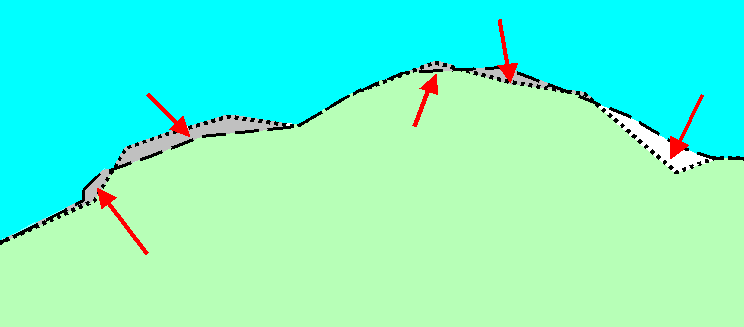Sliver Polygon on:
[Wikipedia]
[Google]
[Amazon]
 A sliver polygon, in the context of
A sliver polygon, in the context of
The Polygon Overlay Operation, E.2.
Geographic information systems Geometric intersection Polygons
 A sliver polygon, in the context of
A sliver polygon, in the context of Geographic Information System
A geographic information system (GIS) consists of integrated computer hardware and Geographic information system software, software that store, manage, Spatial analysis, analyze, edit, output, and Cartographic design, visualize Geographic data ...
s (GIS), is a small polygon
In geometry, a polygon () is a plane figure made up of line segments connected to form a closed polygonal chain.
The segments of a closed polygonal chain are called its '' edges'' or ''sides''. The points where two edges meet are the polygon ...
found in vector data that is an artifact of error rather than representing a real-world feature. They have been a recognized source of error since overlay was first invented in the 1970s.
History
These meaningless polygons were recognized early in the development of GIS. In fact, in 1978Michael Goodchild
Michael Frank Goodchild (born February 24, 1944) is a British-American geographer. He is an Emeritus Professor of Geography at the University of California, Santa Barbara. After nineteen years at the University of Western Ontario, including th ...
found that they constituted the majority of all polygons in some operational GIS. Early programs for performing vector overlay
Vector overlay is an operation (or class of operations) in a geographic information system (GIS) for integrating two or more vector spatial data sets. Terms such as ''polygon overlay'', ''map overlay'', and ''topological overlay'' are often used ...
, such as WHIRLPOOL, developed mechanisms for preventing sliver polygons, such as the "epsilon filter" (fuzzy tolerance) In recent decades, most of the focus of software vendors and practitioners has been on improving the quality of GIS data to prevent them.
Cause, Prevention, Repair
Sliver polygons are typically created when polygons are automatically generated from lines that should be coincident (e.g., an international boundary following a river ''de jure'', or two adjacent counties) but are not, due to the natural discrepancies that arise from manual or automateddigitization
Digitization is the process of converting information into a digital (i.e. computer-readable) format.Collins Dictionary. (n.d.). Definition of 'digitize'. Retrieved December 15, 2021, from https://www.collinsdictionary.com/dictionary/english/ ...
. This can occur when a single layer is digitized and adjacent polygons are traced separately, or during vector overlay when separate polygon layers are merged.
They can be prevented during the digitization process by ensuring that lines that are supposed to be coincident actually are coincident. The editing systems in most GIS software provides for ''snapping'', in which a point placed near an existing point "snaps" to the exact same coordinate. The user can usually control the process, such as setting a ''snap tolerance'' (the maximum distance to consider "close enough"), and which layers and which parts of those layers to snap to. In addition, many systems have ''tracing'' tools, so that newly digitized lines can exactly follow existing lines.
During the overlay process, the preferred mode of sliver polygon prevention is the use of a ''fuzzy tolerance'', which is sometimes called a "xy tolerance" (ArcGIS) or "snapping threshold" (GRASS), and was originally called an "epsilon filter." The user provides a tolerance distance, and as the lines of the input layers are being combined topologically, any lines that are roughly parallel, consistently closer together than the fuzzy tolerance, are combined into a single line. The choice of a proper fuzzy tolerance depends on the situation, especially the scale of the data, and can be a challenge. If it is set too large, narrow but meaningful polygons (e.g., islands in a river) can be collapsed.
If sliver polygons still exist in a data set
A data set (or dataset) is a collection of data. In the case of tabular data, a data set corresponds to one or more table (database), database tables, where every column (database), column of a table represents a particular Variable (computer sci ...
, they may be removed manually or automatically. Some GIS systems provide a tool for ''topological verification'', which searches for topological errors in a data set (sliver polygons being one among many potential types of error), flagging them for correction. One option is to attempt to remove them automatically; many GIS systems provide a tool (usually called Eliminate) that finds very small polygons and merges them into one of the adjacent polygons. There is usually a parameter to pre-select, in situations where there is more than one adjacent polygon, either the largest adjacent polygon or the one with the longest common boundary.
References
{{ReflistExternal links
The Polygon Overlay Operation, E.2.
Geographic information systems Geometric intersection Polygons